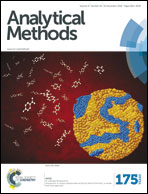Ternary and binary deep eutectic solvents as a novel extraction medium for protein partitioning†
Abstract
This study was devoted to compare ternary and binary deep eutectic solvents (DESs) with aqueous two-phase systems (ATPSs) to extract proteins. Four types of binary DESs and four ternary DESs, composed of a hydrogen bond acceptor (tetramethylammonium chloride, TMAC) and hydrogen bond donors, were synthesized. The phase diagrams of the studied DESs demonstrated that binary DESs were more amenable to producing a two-phase split. Afterwards, their ability to extract four different substances was further evaluated. It was found that the systems based on ternary DESs showed a better potential in the field of extraction. Two types of DESs with ATPS, involving TMAC–urea (TMAC–U) and TMAC–glycerol–urea (TMAC–G–U), were investigated for five influence factors such as the amount of DES, concentration of salt, mass of BSA, temperature and pH, on the extracting of bovine serum albumin (BSA). Under the optimal conditions, the values of their respective extraction efficiency were up to 99.31% and 98.95%. Moreover, the back extraction efficiencies were discussed, which indicated that the ternary DESs reached up to 71.89%, remarkably different from binary DES (21.02%). Finally, UV-vis, Fourier transform infrared spectrometry (FT-IR), circular dichroism (CD), dynamic light scattering (DLS), conductivity measurements and transmission electron microscopy (TEM) were utilized to study the extraction mechanism. This study reveals the outstanding feasibility of TMAC–G–U based DES with an ATPS for the protein extraction process, providing significant information for designing task-specific DESs.


 Please wait while we load your content...
Please wait while we load your content...